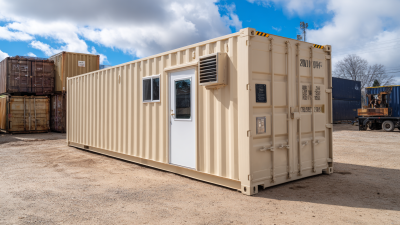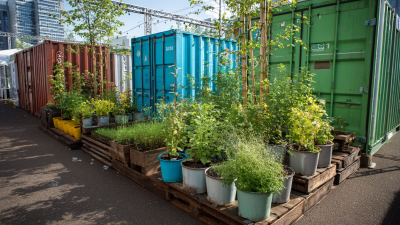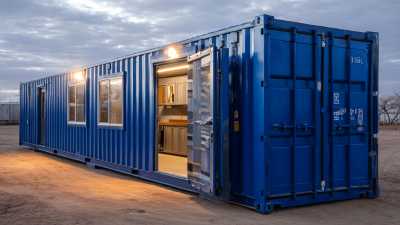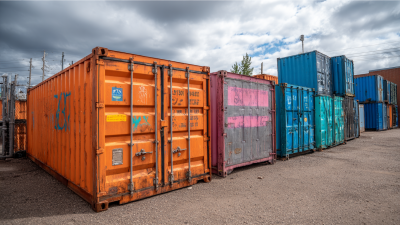In recent years, the versatility of the 40ft shipping container has garnered significant attention across various industries, signaling a shift in both storage solutions and sustainable living practices. According to the World Shipping Council, the global container port throughput reached a staggering 802 million TEUs in 2021, highlighting the widespread utilization of shipping containers worldwide. Beyond their primary function in transporting goods, these containers have increasingly been repurposed for innovative uses, from temporary storage facilities to fully equipped homes. A report from Research and Markets estimates that the global market for container homes is expected to grow at a compound annual growth rate (CAGR) of 5.2% between 2022 and 2027, driven by a growing demand for affordable housing solutions. This exploration into the multifaceted applications of the 40ft shipping container showcases not only its economic potential but also its role in promoting sustainable practices in construction and urban development.

The 40ft shipping container has emerged as a versatile storage solution, ideal for various applications across industries. According to a report by IBISWorld, the global shipping container market has seen a growth rate of 4.8% per year, underlining the increasing demand for efficient storage solutions. These containers provide a secure and configurable option for businesses and individuals alike, capable of holding up to 2,700 cubic feet of cargo. This substantial space makes them suitable for everything from commercial inventory storage to overflow household items.
Moreover, the adaptability of 40ft containers extends beyond traditional storage definitions. A study from Mordor Intelligence highlights that the construction sector is increasingly turning to repurposed shipping containers for building structures due to their durability and cost-effectiveness; they can reduce construction costs by up to 30% and timeline by 40%. This aspect positions shipping containers as not only practical storage solutions but also as innovative options for sustainable living. As urban space becomes scarcer, the ability to maximize storage and living space with these containers reflects a growing trend towards efficiency and sustainability in modern living.

Shipping containers, often seen as mere storage units, have emerged as innovative building blocks for sustainable living. These versatile structures offer a unique solution to housing challenges, transforming urban spaces into functional, stylish homes. One of the most appealing aspects of using shipping containers for residential purposes is their modular nature, allowing for easy stacking and arrangement to create personalized living spaces. This modularity not only fosters creativity in design but also facilitates efficient use of land, making it ideal for tight urban environments.
Moreover, the process of repurposing shipping containers for homes contributes significantly to sustainability. By utilizing recycled materials, homeowners can reduce their carbon footprint while simultaneously addressing issues of waste and pollution. The insulating properties of shipping containers can also be enhanced, making them energy-efficient living spaces that are more environmentally friendly than traditional homes. Creative adaptations such as installing large windows, green roofs, and integrating solar panels further augment their ecological viability. As innovative uses for shipping containers continue to evolve, they redefine not only how we think about housing but also how we can achieve sustainable living.
| Usage Type | Description | Area (sq ft) | Cost Range ($) | Benefits |
|---|---|---|---|---|
| Storage Solutions | Ideal for temporary or long-term storage of goods. | 320 | 1,500 - 3,000 | Secure, weather-resistant, and portable. |
| Mobile Offices | Converted into functional office space for businesses. | 320 | 3,000 - 5,000 | Cost-effective, customizable, and relocatable. |
| Sustainable Homes | Eco-friendly housing solutions utilizing recycled materials. | 320 - 640 | 20,000 - 40,000 | Innovative, energy-efficient, and low-cost living. |
| Pop-up Shops | Temporary retail spaces for businesses or events. | 320 | 2,000 - 4,000 | Flexible, affordable, and engaging commercial space. |
| Art Studios | Creative spaces for artists to work and showcase art. | 320 | 1,500 - 3,500 | Inspiring, customizable, and unique atmosphere. |
Shipping container homes are rapidly gaining popularity as a sustainable living solution, reshaping our understanding of modern housing. One of the key eco-friendly features of these structures is their use of recycled materials, significantly reducing the demand for new construction resources. By repurposing shipping containers that would otherwise contribute to waste in landfills, these homes promote a circular economy and minimize environmental impact. Furthermore, the robust steel structure of containers offers durability and longevity, which diminishes the need for frequent repairs and replacements.
Additionally, shipping container homes can be designed with energy efficiency in mind. Many builders incorporate solar panels, rainwater harvesting systems, and thermal insulation to reduce energy consumption and increase self-sufficiency. These elements not only lower utility costs but also facilitate a lifestyle that prioritizes environmental stewardship. The modular nature of shipping containers allows for innovative designs that can adapt to various climates and terrains, providing a versatile and sustainable housing option for those seeking to lessen their ecological footprint while enjoying the comforts of modern living.
When it comes to shipping container renovations, effective budgeting and planning are crucial to ensure a successful transformation. According to a 2022 report by the Container Housing Institute, the average cost of converting a 40ft shipping container can range from $10,000 to $35,000, depending on the complexity of the design and amenities included. This affordability makes container homes an attractive alternative to traditional housing. With increased demand, the market for container homes is projected to grow by 17% annually over the next five years, reflecting a shift towards sustainable living solutions.
To maximize savings, it’s essential for prospective builders to prioritize their renovation goals and understand potential costs upfront. A recent survey by the Modular Building Institute indicated that 60% of container home developers recommend thorough planning to avoid unforeseen expenses, such as additional land preparation or utility installations. By setting a clear budget and timeline, individuals can effectively navigate the challenges of container projects while benefiting from their eco-friendly and cost-effective advantages. Embracing this modern housing trend not only reduces material waste but also presents innovative ways to create functional living spaces suited to diverse lifestyles.
Shipping containers are increasingly becoming a popular choice for innovative and sustainable living spaces. The versatility of a 40ft container allows for extensive modifications that enhance comfort and functionality, making them ideal for modern homes. By incorporating windows and insulation, these containers can turn into cozy, energy-efficient residences. Additionally, the use of eco-friendly materials for flooring and water-saving fixtures can significantly reduce the ecological footprint of container homes.
Tips for creating a comfortable container home include prioritizing natural light. Strategically placed windows or skylights can brighten the space and promote a healthy living environment. Another important consideration is ventilation; installing mechanical or passive systems ensures fresh air circulates, preventing moisture buildup and maintaining overall comfort. Lastly, don’t underestimate the power of smart storage solutions such as built-in shelves or multifunctional furniture, which can maximize space without compromising style.
Transforming a standard shipping container into a functional home involves mindful design choices that cater to both aesthetics and practicality. Thoughtful layout planning can create distinct living areas while maintaining an open, inviting atmosphere. Emphasizing sustainable practices, such as incorporating solar panels and rainwater collection systems, further enhances the appeal of container living, merging modern convenience with environmental responsibility.








